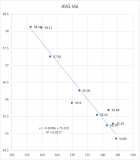Hey folks, thought Id share some experience reloading the "new to me" 350 Rem Mag. Hopefully I can learn something along the way here. I am attempting to work up a deer hunting load, and have been thru several iterations now, with multiple guns.
Due mainly to obsolescence, the 350RM is plagued by poor brass availability. One must either form brass from something else, buy expensive new old stock cartridges and shoot them to get the brass, or if you are really luck, stumble into some new old stock virgin brass. Ive been really lucky and have a few boxes of NEW Nosler brass as well.
To start with, in order to save my GOOD brass, I formed brass from once fired Federal 7mm Rem Mag. The process works very well, even neck turning, and I had easy to make shootable brass. I worked up loads in both guns, no pressure signs for either, but noticed the velocities were VERY high. Like 2700fps+ from 225gr bullets out of 21 inch barrels. By all load manuals, even 24 inch barrels should be 2600 or less.
So I decided to check my same load, 55.5gr H4895, 225gr SMK from once fired authentic Remington 350RM brass, and also the new Nosler brass. Both shot equally well, with progressively slower velocities, Remington then Nosler. Ive settled on the new Nosler brass for this hunting season at least, 225gr bullet at 2530fps. Much more realistic velocities, and right at MOA accuracy.
So I decided to weigh some cleaned cases and get some averages:
Is it "normal" for ~20gr increased brass weight [reduced internal volume] to equate to roughly 170-200fps increase in velocity?
Is there a brand of brass [7mm Rem Mag] that is thinner overall and might better represent either the R-P or Nosler authentic 350RM brass? [Id like to put round count on something more readily available, and save my authentic brass for times when proper head stamp is needed]
Due mainly to obsolescence, the 350RM is plagued by poor brass availability. One must either form brass from something else, buy expensive new old stock cartridges and shoot them to get the brass, or if you are really luck, stumble into some new old stock virgin brass. Ive been really lucky and have a few boxes of NEW Nosler brass as well.
To start with, in order to save my GOOD brass, I formed brass from once fired Federal 7mm Rem Mag. The process works very well, even neck turning, and I had easy to make shootable brass. I worked up loads in both guns, no pressure signs for either, but noticed the velocities were VERY high. Like 2700fps+ from 225gr bullets out of 21 inch barrels. By all load manuals, even 24 inch barrels should be 2600 or less.
So I decided to check my same load, 55.5gr H4895, 225gr SMK from once fired authentic Remington 350RM brass, and also the new Nosler brass. Both shot equally well, with progressively slower velocities, Remington then Nosler. Ive settled on the new Nosler brass for this hunting season at least, 225gr bullet at 2530fps. Much more realistic velocities, and right at MOA accuracy.
So I decided to weigh some cleaned cases and get some averages:
- Formed once fired FC 7mm Rem Mag = 222.4gr
- Once fired R-P 350 Rem Mag = 215.9gr
- New Nosler 350 Rem Mag = 203.1gr
Is it "normal" for ~20gr increased brass weight [reduced internal volume] to equate to roughly 170-200fps increase in velocity?
Is there a brand of brass [7mm Rem Mag] that is thinner overall and might better represent either the R-P or Nosler authentic 350RM brass? [Id like to put round count on something more readily available, and save my authentic brass for times when proper head stamp is needed]












